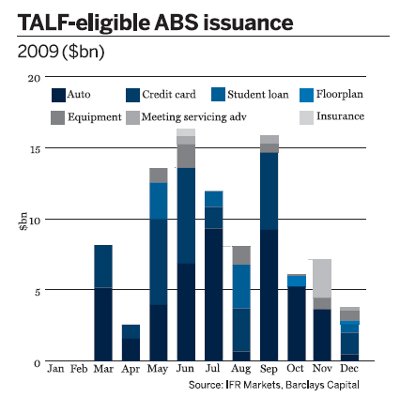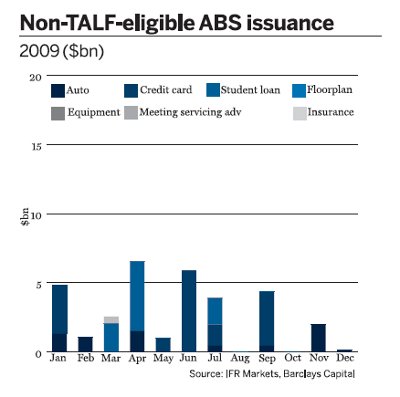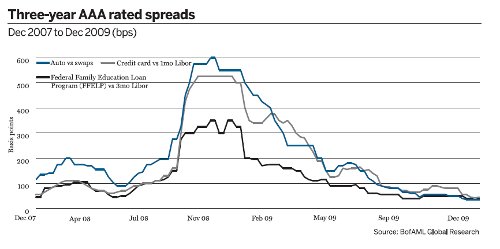With a few deals signalling the resuscitation of the global asset-backed securities market, bankers say it is gingerly getting back on its feet. But it faces a barrage of political, regulatory and accounting constraints that will make any recovery slow and painful. Writer Suzanne Miller
Oh, for the good old days of Enron. Back then, bankers in the securitisation business really thought they had something to worry about as regulators clamped down on the use of special purpose entities (SPEs), which were liberally used by the likes of Enron to sweep assets off balance sheets. Many feared that regulatory intervention would sully the market's growth and sterling reputation. And yet, the market went on to reach dizzy new heights in volume and performance.
Fast-forward to 2010. Today, the US market is staring down such a thicket of political, regulatory and accounting constraints that there are fears the market may not recover as it did once before. Issuers face the prospect of retaining more risk in issues, while new accounting rules will make it much tougher to treat securities as off-balance-sheet assets. While banks like the low funding cost that asset-backed securities (ABS) make possible - a benefit that will continue - they have also traditionally relied on this market as a way to cash in on the lower cost of capital tied to off-balance sheet treatment.
Ted Yarbrough, head of global securitised products at Citigroup, says the biggest risk for the market is uncertainty regarding the various legislative and regulatory initiatives surrounding securitisation.
In January, he attended the American Securitization Forum - a group that holds annual gatherings for the industry. Although traditionally held in Nevada, this year it was tellingly held in Washington, DC - the regulators' backyard. Mr Yarbrough said he found no lack of people with money to lend and invest. "The big question is - what are the rules? Until there's clarity, it is going to be difficult - whether it is concern about capital implications given changes in accounting rules, risk-retention requirements, the Federal Deposit Insurance Corporation safe harbour rule. All of this raises a lot of questions."
Moreover, markets are only just emerging from one of the worst credit crises ever - so many are watching closely as US and European regulators dismantle life supports for the securitisation market.
In March 2010, the US Federal Reserve will end the Term Asset-Backed Securities Loan Facility (TALF), with most bankers thinking it unlikely that the scheme will be extended. The subsidised programme was designed to entice investors into buying newly issued AAA rated securitisations backed by eligible asset classes, which ultimately included credit cards, auto loans and leases, student loans, small business loans and commercial mortgages. Without it, most agree that securitisation would have fallen off the cliff.
In Europe, regulators are considering risk-retention rules and more stringent due-diligence requirements, which concern bankers more than the European Central Bank's (ECB's) imminent plans to begin withdrawing its unprecedented liquidity support for the market. From the end of 2010, it will no longer accept repo collateral rated below A- and will require eligible ABS issues to have two AAA ratings.
Bankers say they are not particularly worried. First, the majority of ABS paper used for ECB repos is already AAA as the market for BBB paper has remained largely shut since the crisis.
Perhaps more importantly, there is an estimated €1000bn or more in ABS that were structured and/or retained for repo purposes since mid-2008, with the EuroSystem believed to be holding half of that, says Alexander Batchvarov, international structured finance strategist with Bank of America Merrill Lynch in London. "Any quick liquidation of repos would lead to a significant widening, which we don't think the ECB will let happen," he says. Mr Batchvarov believes it is more likely that banks will gradually place deals originally structured for repo purposes on the market.
Life after talf
In the US, bankers are also sanguine about the imminent loss of TALF, because a growing number of new deals have been placed outside the TALF programme in recent months and spreads have tightened dramatically. Three-year floating-rate AAA rated credit card issues have come in to 45 basis points (bps) over Libor versus a peak of 525bps in 2008.
On January 27, for example, Nissan Motor Acceptance Corp priced $900m in an AAA rated ABS floorplan issue (to finance dealerships), increased from $750m. Michael Wade, managing director and head of asset securitisation origination for the Americas at Barclays Capital, and co-manager for the deal, said that although the issue was TALF-eligible, no TALF buyers participated.
"The Nissan deal was priced at 115bps over Libor, so investors got only slightly more spread than the cost of the TALF loan," says Mr Wade. "This transaction shows that the market has largely weaned itself off the programme for high-quality issuers and collateral." Last year, these floorplan issues were trading at spreads of 700bps to 800bps in the secondary market.
Still, many are cautious. So-called 'off-the-run' issues such as floorplans and private student loans could feel a sting when TALF is pulled. Commercial mortgage-backed securities (CMBS) are particularly vulnerable. Analysts estimate that $2700m of these loans will come due by 2014. Although more CMBS deals could be done before TALF expires, analysts doubt it will be enough to fix the looming refinancing problem.
"The market wanted to see a TALF extension for the less liquid asset classes," says Mr Wade. "But for those like auto loans and credit cards, the end of TALF is likely a non-event".
That is not to say issues in those sectors will soon be flying off the shelf. Forecasts for 2010 call for a slight decline in overall volume, with Bank of America Merrill Lynch suggesting new issue volume will reach $150bn, down from $172.59bn last year. Last year's issuance included $105bn TALF-eligible deals and about $25bn of subordinated classes (most retained by issuers). New volume will be impacted by tighter underwriting standards, constrained consumer spending and a related lack of growth in receivables.
Theresa O'Neill, ABS strategist with Bank of America Merrill Lynch, says the good news is that more investors are willing to buy outside the TALF programme. "Participation by traditional investors not using TALF funds increased over the course of the year. We expect demand from these investors will remain strong post-TALF," she says.
In all, investors used $50bn of TALF funds to purchase eligible ABS last year. That represented about 55% of TALF-eligible consumer ABS issuance.
In the FASB's Shadow
Barclays' Mr Wade is bullish about the ABS sector, but admits there are concerns: "It is the accounting world that worries me. Current accounting changes and resultant capital changes could make it more difficult or less efficient for issuers to use securitisation."
Specifically, the Financial Accounting Standards Board's new rules - FAS 166 and FAS 167 - raise concern about the future of off-balance-sheet treatment. FAS166 could force the consolidation of many off-balance-sheet structures, including credit card ABS, calling into question the legal isolation of the securitisation.
Bankers are hoping for a compromise. Potential legislative measures may also force a creditor or securitiser to retain 5% of the credit risk on any loan or asset that is transferred by the former and securitised by the latter. In addition, the Federal Deposit Insurance Corporation is contemplating additional data disclosures and enhanced deal documentation, which could make the securitisation process more costly.
Issuers in Europe face similar rules under the forthcoming risk-retention requirement for European securitisations under the EU capital requirements directive. This rule, which takes effect in Europe in 2011, will require European banks to retain 5% of securitisations that they originate and place with investors. "The big question now is how much regulatory capital will be applied to meet the retention requirement," asks Mr Batchvarov. And tougher due-diligence rules are likely too.
But even as European bankers fret about new regulations, they are busy testing the waters with new deals. In September, Barclays co-managed a £3.6bn (€4.1bn) residential mortgage-backed notes from Lloyds Bank's Permanent Master Trust - the first public deal from the trust since May 2008. It was an important litmus test because, among other factors, investor appetite for publicly offered ABS deals was still untested in Europe. The two-tranche floating-rate sterling and euro issue, priced respectively at 180bps and 170bps over Libor, attracted 56 investors from 16 jurisdictions, mostly in Europe. In the secondary market, prices tightened to a spread of 150bps.
While this is still gargantuan when compared with spreads for comparable issues just a few years ago, bankers credit the deal with cracking the markets back open and proving investors are willing to play. Since the Lloyds deal, a few other ABS deals have been priced and more are in the pipeline.
The next test for any real recovery will be the ability to sell BBB tranches - which has been conspicuously absent so far. "It is not that they can't be sold, but that the issuers' objective is to achieve pure funding at the AAA level," says Brad Craighead, head of origination and structuring for European ABS at JPMorgan in London. So far, he says, deals have been placed to achieve funding diversification, not capital relief. And also, non-AAA mezzanine pricing levels remain extremely wide.
The US faces the same BBB challenge, says Citi's Mr Yarbrough: "The resurgence of the AAA market is obviously very positive, but it will also be necessary for the subordinated market to continue to recover in order for securitisation to be fully effective, especially for non-bank finance companies."
Bankers say it is just a matter of time before yield-hungry investors come knocking. Are they too optimistic? Perhaps they are remembering how the sector rose again after the dark days of Enron. It helps that ABS bankers tend to be a gritty bunch who innovate when times are tough. They have done it before. Many are betting they will do it again.





